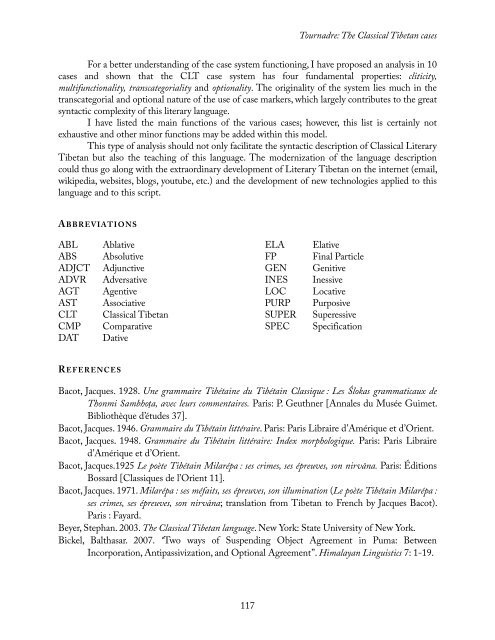The Classical Tibetan cases and their transcategoriality
The Classical Tibetan cases and their transcategoriality
The Classical Tibetan cases and their transcategoriality
Create successful ePaper yourself
Turn your PDF publications into a flip-book with our unique Google optimized e-Paper software.
117<br />
Tournadre: <strong>The</strong> <strong>Classical</strong> <strong>Tibetan</strong> <strong>cases</strong><br />
For a better underst<strong>and</strong>ing of the case system functioning, I have proposed an analysis in 10<br />
<strong>cases</strong> <strong>and</strong> shown that the CLT case system has four fundamental properties: cliticity,<br />
multifunctionality, <strong>transcategoriality</strong> <strong>and</strong> optionality. <strong>The</strong> originality of the system lies much in the<br />
transcategorial <strong>and</strong> optional nature of the use of case markers, which largely contributes to the great<br />
syntactic complexity of this literary language.<br />
I have listed the main functions of the various <strong>cases</strong>; however, this list is certainly not<br />
exhaustive <strong>and</strong> other minor functions may be added within this model.<br />
This type of analysis should not only facilitate the syntactic description of <strong>Classical</strong> Literary<br />
<strong>Tibetan</strong> but also the teaching of this language. <strong>The</strong> modernization of the language description<br />
could thus go along with the extraordinary development of Literary <strong>Tibetan</strong> on the internet (email,<br />
wikipedia, websites, blogs, youtube, etc.) <strong>and</strong> the development of new technologies applied to this<br />
language <strong>and</strong> to this script.<br />
A BBREVIATIONS<br />
ABL Ablative ELA Elative<br />
ABS Absolutive FP Final Particle<br />
ADJCT Adjunctive GEN Genitive<br />
ADVR Adversative INES Inessive<br />
AGT Agentive LOC Locative<br />
AST Associative PURP Purposive<br />
CLT <strong>Classical</strong> <strong>Tibetan</strong> SUPER Superessive<br />
CMP Comparative SPEC Specification<br />
DAT Dative<br />
R EFERENCES<br />
Bacot, Jacques. 1928. Une grammaire Tibétaine du Tibétain Classique : Les Ślokas grammaticaux de<br />
Thonmi Sambhoṭa, avec leurs commentaires. Paris: P. Geuthner [Annales du Musée Guimet.<br />
Bibliothèque d’études 37].<br />
Bacot, Jacques. 1946. Grammaire du Tibétain littéraire. Paris: Paris Libraire d’Amérique et d’Orient.<br />
Bacot, Jacques. 1948. Grammaire du Tibétain littéraire: Index morphologique. Paris: Paris Libraire<br />
d’Amérique et d’Orient.<br />
Bacot, Jacques.1925 Le poète Tibétain Milarépa : ses crimes, ses épreuves, son nirvāna. Paris: Éditions<br />
Bossard [Classiques de l’Orient 11].<br />
Bacot, Jacques. 1971. Milarépa : ses méfaits, ses épreuves, son illumination (Le poète Tibétain Milarépa :<br />
ses crimes, ses épreuves, son nirvāna; translation from <strong>Tibetan</strong> to French by Jacques Bacot).<br />
Paris : Fayard.<br />
Beyer, Stephan. 2003. <strong>The</strong> <strong>Classical</strong> <strong>Tibetan</strong> language. New York: State University of New York.<br />
Bickel, Balthasar. 2007. “Two ways of Suspending Object Agreement in Puma: Between<br />
Incorporation, Antipassivization, <strong>and</strong> Optional Agreement”. Himalayan Linguistics 7: 1-19.
















